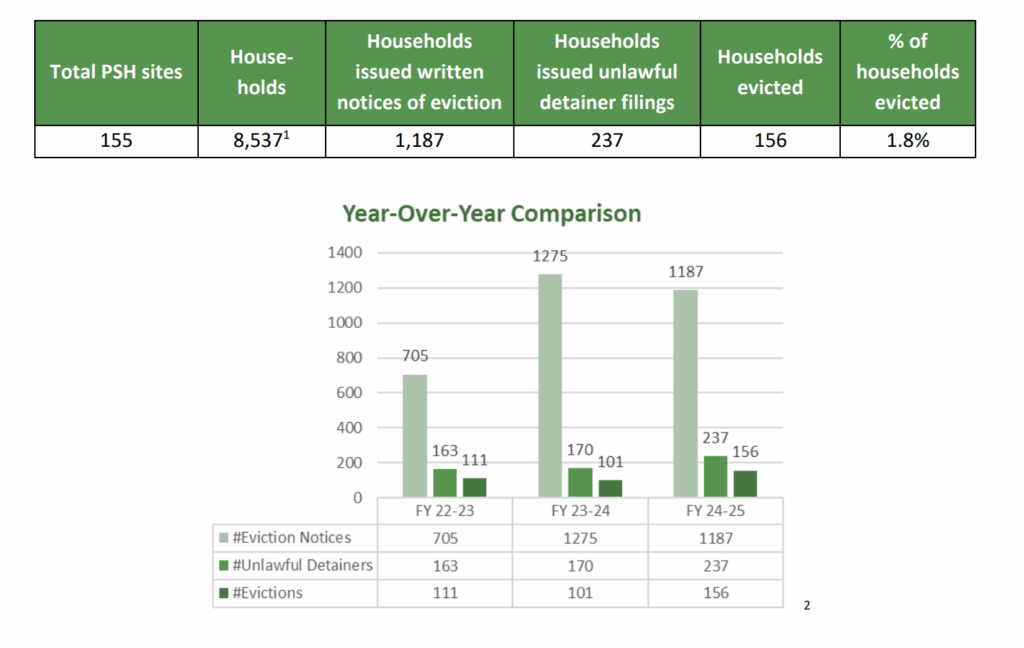by Jordan Wasilewski

On September 2, the Department of Homelessness and Supportive Housing (HSH) sent its report on evictions from Permanent Supportive Housing (PSH), as required by City law. For background, the ordinance requiring annual reports was pushed by then-Supervisor Mark Farrell in 2015 with little stakeholder engagement.
The report indicates the number of written notices (notifications of a landlord’s intent to initiate eviction process), unlawful detainers (the process of eviction in court), and actual eviction (tenants removed from their units), for reasons of non-payment, lease violations, or a combination. Yet, the report doesn’t count what I refer to as “backdoor evictions”—voluntary removing oneself from the property by a certain date after making a deal with management or during the eviction process to avoid an eviction on record, as revealed in a 2022 investigative report in the San Francisco Chronicle.
This year’s report is in a much more reader-friendly format than the eviction report from fiscal year 2019-20, which was when I started diving into data back when I was making the case that lowering rents to 30% of income would mean fewer evictions for non-payment. Still at the time of this writing, I had to print out the report, find ways to deal with the small-print format, and it involved an excessive amount of marginalia.
The good news is that compared to before the #30RightNow campaign to limit rents to 30% of tenants’ incomes, both unlawful detainers and evictions for non-payment have decreased. Between FY2019-20 and FY2024-25, unlawful detainers in PSH went down from 122 to 79, as did actual non-payment evictions, from 65 to 26. This is a testament to the effectiveness of lowering rents, plus guidance from HSH that was released in 2023 dealing with non-payment issues .
And of course, we should always consider that this data may be incomplete. While there was a correlation between sites where tenants were rent-burdened and numbers of eviction notices in FY 2019-20, that didn’t always track to actual evictions—however, this was prior to “backdoor evictions” being exposed.
In addition, a majority of PSH sites (89 of the 156 counted) have had no evictions in FY 2024-25. In terms of total numbers of evictions, 35 sites have had one eviction each, 11 sites have had two evictions each, 6 sites have had three evictions each, 4 sites have had four evictions each, 5 sites have had five evictions each, 2 sites have had six evictions each, and 4 sites have had seven evictions each. Among those sites that have had three or more evictions, the sites with the highest eviction rates are the Allen Hotel (10%), the Ambassador Hotel (9.5%), the Camelot Hotel (8.6%), the National Hotel (6.8%), and the Royan Hotel (5.4%). With one exception (the Mission Hotel), all sites that had three or more evictions had an eviction rate that exceeded 2%, HSH’s goal limit for PSH eviction rates.
Now, onto the bad. We are still seeing a high level of evictions for lease violations. In FY 2019-20, there were 86 evictions for lease violations, which increased to 100 in FY 2024-25. Since last year, the percentage of evictions out of all PSH households has increased from 1.2% to 1.8%. Out of the 21 sites where there have been more than three evictions, seven are managed by the Tenderloin Housing Clinic, four are managed by Conard, three are managed by Episcopal Community Services (ECS), and three are managed by Tenderloin Neighborhood Development Corporation. While I was initially eyeballing the data, I noted that the ECS buildings had a higher number of eviction notices. I also noticed that many of the sites with higher eviction rates were more likely to be older, more spartan, and crowded SROs.
Through all this, the legislation has not been updated to potentially detect backdoor evictions. We also don’t have enough context about evictions for lease violations, which could be based on serious issues such as assault or fire setting, or smaller issues, such as minor violations of the visitor policy or a manager acting like a drill sergeant.
Where things get ugly is the number of legal evictions exceeding unlawful detainers, considering that, logically, evictions must only be followed by detainers. This might be due to “behave and stay” agreements, in which the provider/landlord agrees to not go through the eviction with a tenant if they sign stipulated agreements that often sets up people to fail. An example from the 2022 Chronicle investigation included a tenant who was kicked out for cursing off a desk staff while under a behave and stay. These situations might account for unlawful detainers being filed in one fiscal year, then leading to an eviction in the following year, which complicates data collection.
While there is a lot to examine in this report, we need to focus on current and future solutions for evictions in permanent supportive housing. Data collection can play a role: City law should be amended to require that backdoor evictions be reported. Also, the data should be aggregated by agency, so we can see trends. Furthermore, if there is an unlawful detainer that is still pending at the end of a fiscal year, it should also be counted in the next fiscal year.
In terms of solutions for nonpayment evictions, HSH guidance on nonpayment should be codified as a binding policy providing concessions to both tenants (by allowing them to pay rent by check or remotely) and to providers (by allowing them to require tenants who are habitually in arrears to enroll in third party payee programs to pay off the arrears.
In terms of lease violation evictions, HSH doesn’t even have non-binding guidelines, including what level where eviction is necessary, or limitations on “behave and stay” agreements.
I know that things have been tough with Daniel Lurie and the six moderate Supervisors playing more conservative tunes, but we must not give up hope. Supervisor Chyanne Chen is pushing legislation around demolition evictions, and Jackie Fielder stands to continue the work that Dean Preston started.
If any politician truly cares about the state of our streets and downtown recovery, they should invest in keeping the most vulnerable housed. Our success as permanent supportive housing tenants counts on it.

